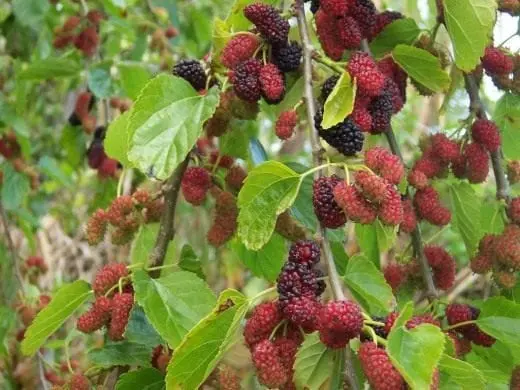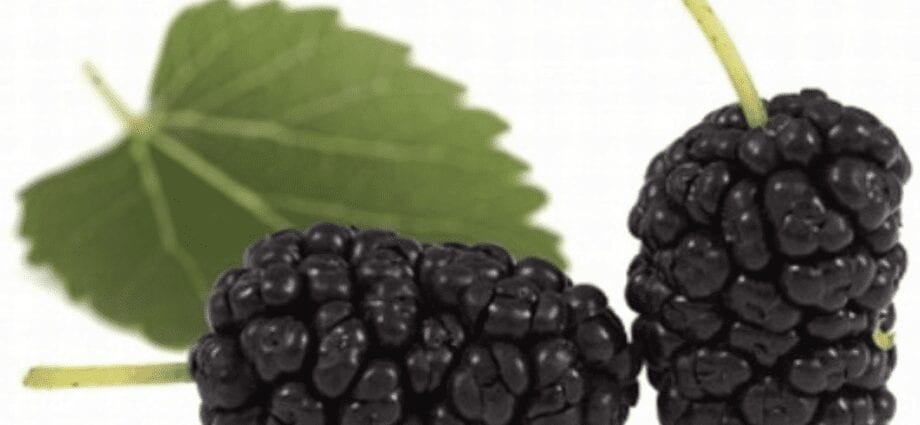Contents
Description
Mulberry is a tree from the mulberry family. Persia is the official homeland of the mulberry tree. In Afghanistan and Iran, it appears to be a “family” tree and people plant it in almost every yard. Nowadays it grows in Europe, North America, Africa, and Asia. People were using the fruits of the black mulberry long before the birth of Christ. According to legend, this tree still grows in the city of Jericho, in the shade where Jesus was hiding.
Mulberry grows very quickly at first, but with age, this process stops. The standard crop height is 10-15 m, dwarf varieties grow up to 3 m. Mulberry is a long-lived tree. Its life span is about two hundred years, and under good conditions – up to five hundred. Today there are about sixteen species and four hundred varieties of mulberry. Mulberry is easy to grow. It tolerates both winter touches of frost and summer droughts. It grows on almost any soil. By trimming, you can achieve a thicker and more spherical crown. Check out how the farm looks like it this video:
The tree bears fruit annually and is abundant. Mulberries are perishable and do not tolerate transportation well, especially over the long distances. Optimal storing is three days in a plastic bag in the refrigerator, without losing their taste and appearance. Frozing or drying is a solution to extend this period.
History of mulberry
They learned to grow mulberries more than 4 thousand years ago. The popularity of the plant in agriculture is associated with the development of farms for the production of natural silk. Mulberry was used to feeding nondescript worms working on the creation of expensive fabric. When the fruits of the plant started to eat people is unknown, however, there is information that for a long time it has been cultivated on the fertile plains of Turkey, Russia, and other regions of the world.
The plant bears fruit abundantly every year. The harvest taken from one tree can reach 200 kg or more. The mulberry berry ripens by the end of July. The plant is widespread in Greece on the island of Morea (the medieval name of the Peloponnese peninsula). According to one version of scientists, the word morea comes from morus, which translates as mulberry. The plant has been cultivated in Greece since ancient times. Its appearance in the Peloponnese as an agricultural crop probably dates back to the end of the 6th century.
Most effective growing methods
The best way to grow is in 10-15 L containers with fertile soil in a greenhouse. Then there will be no need to dig in the seedlings for the winter before planting, but to store them in containers and plant them in early spring in the pits prepared for planting.
Also, you will not need to shorten the aerial part by 4-5 buds. When planted in containers for 7-8 years, mulberries will bear fruit. Forming with only green pinching and no pruning shears. An infection that gets into the wound surface easily inhibits the development of the seedling, or it will destroy it. Watering and feeding is required only once in late spring. At the end of September, tweeze all young shoots to induce rapid lignification of the shoots and prepare for wintering.
Types and varieties
Mulberry is a genus of flowering plants of the Mulberry family, which includes 10-16 species of deciduous trees, both wild and cultivated in many regions of the world. They produce edible fruits that are prized in cooking. The mulberry berry is similar to the blackberry but differs in color. It has a light red, purple, or crimson hue. The fruits of the plant are classified according to the color of the berries into two main types.
• Morus (red mulberry) – home in North America.
• Morus Alba (white mulberry) – native to the eastern regions of Asia.
In addition to the “pure” species of mulberry, there are berry hybrids. So, in Europe, black mulberry grows, in North America, red and dark purple.
Mulberry fruits are most often found on the counter in the form of dried fruits. Mulberry leaves, roots, and twigs are sold in stores as dried medicinal preparations, and the seeds are intended for growing the plant at home. Those with a sweet tooth can enjoy mulberry fruit bars available from some manufacturers.
Composition of berries


Mulberry fruits have almost the record content of potassium and will be especially beneficial for people who suffer from the lack of this element. In addition, berries are rich in vitamins E, A, K, C, as well as vitamins of group B. Among trace elements there are manganese, selenium, copper, iron and zinc, and among macronutrients – magnesium, calcium, phosphorus and sodium.
Mulberry calorie content is 43 kcal.
Black silk: useful properties
Mulberry fruits are medicinal. Berries are very beneficial for the digestive tract. Unripe – they have an astringent taste and are able to remove heartburn, and ripe – are wonderful disinfecting in case of food intoxication. People are using overripe mulberries as a laxative. In addition, ripe fruits is a good diuretic. Berries helps to recover in the postoperative period and during heavy physical exertion.
Due to the presence of vitamin B, which have a good effect on the nervous system, mulberry normalizes sleep and soothes in stressful situations. Magnesium and potassium in the composition of berries helps the processes of hematopoiesis. Taking a few glasses of mulberries a day can help stabilize hemoglobin levels. And due to the fact that 100 g of berries contain only 43 to 52 kcal, people can eat it even during diets. Mulberry will be useful for people suffering from chronic swelling due to malfunctioning of the kidneys or heart.
Contraindications of black mulberry


It’s a common recommendation not to consume low-quality berries – this can negatively affect digestion. In addition, mulberry berries absorb salts of heavy metals; therefore, the use of fruits growing in an unfavorable ecological environment is not good for the health. You should also not consume mulberry or berry juice along with other berry juices, as it might cause fermentation.
The best option is to take them thirty minutes before meals, on an empty stomach. Mulberries, in rare cases, can cause allergies. Mulberry fruits Hypertensive patients are usually taking mulberry fruits with caution and under supervision, especially in hot weather, as their use can lead to increased blood pressure. Due to its sweetness (about 20% of sugars), mulberries are not recommended when having diabetes.
Application of mulberry
The mulberry is food and colorant, and its wood due to its lightness and strength is used for the production of musical instruments. People extract sugar and vinegar from the fruit of the black mulberry. It’s better to eat berries freshly picked, or process it into soft drinks, wines, and vodka-mulberry. The fruits are also great for making jams, jellies, and syrups, adding them to baked goods, made pastilles, and sorbets. In some countries, people are using mulberry berries to make bread.
Taste qualities
Mulberry is denser in consistency than blackberry. It has a fleshy juicy pulp. Mulberry fruits have a sweetish taste with a slight sourness, a bit like dried figs. The red berry, which grows in the eastern part of America, has a very rich aroma, while the Asian white berry has a refreshing sweetish taste without aroma, slightly tart, and without acidity.
Cooking applications
Mulberries are dried and added as a filling to pies. Wine, syrups, liqueurs, artificial honey “bekmes” are made from the berries. The leaves and roots of the tree are used in the production of medicinal preparations and tea.
How to cook mulberries?
- Cook mulberry compote.
- Prepare tincture, wine, or vodka.
- Make a paste and garnish ice cream with it.
- Prepare mulberry sorbet.
- Bake a pie stuffed with berries.
- Make jelly, creamy dessert, or jam with lemon zest.
- Boil artificial honey from white berries.
- Add to muesli instead of raisins for breakfast, for instance.
- Prepare a cocktail.
- Mix with creamy yogurt.
With what to combine mulberry?
- Dairy products: ice cream, cream, cow’s or soy milk, butter, yogurt.
- Meat: game, hare, venison.
- Sweet / Confectionery: sugar.
- Alcoholic drinks: port, blackcurrant, blackberry, or elderberry liqueur, cognac.
- Berry: elderberry, black currant, blackberry.
- Fruit: lemon.
- Cereals / Mixes: oatmeal, muesli.
- Spices / Condiments: vanilla.
- Flour: rye or wheat.
- Walnut: walnut.
Scientists classify the berry as the one that easily damages and is a perishable food, therefore we recommend to eat it fresh. We can store it in the refrigerator for about 3 days. The best way to transport the berries is to freeze them or to dry.
Mulberry: healing properties


The bark, branches, roots, fruits, and leaves are good for medicinal purposes. For example, tincture of bark or root is good as a general tonic, as well as for bronchitis, asthma and hypertension. A mixture of vegetable oil and crushed bark remarkably heals burns, eczema, purulent wounds, psoriasis and dermatitis.
A decoction of the leaves is a good adjuvant in diabetes, for fever, and as an antipyretic. Berry juice is rinsing the throat and mouth. Daily consumption of large quantities of berries per day (300 g, four times a day) helps in the treatment of myocardial dystrophy and removes its symptoms. Berries stimulate tissue regeneration, including the organs of vision.










